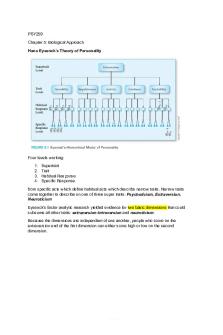Study designs - summary of biostatistics concepts PDF

| Title | Study designs - summary of biostatistics concepts |
|---|---|
| Course | Epidemiology and Biostatistics 481 |
| Institution | Curtin University |
| Pages | 1 |
| File Size | 89.1 KB |
| File Type | |
| Total Downloads | 26 |
| Total Views | 137 |
Summary
summary of biostatistics concepts...
Description
Classification of study designs (Version 8) (Qualitative studies are not included in this scheme; categories shown are not necessarily mutually exclusive, hybrid and mixed designs are possible)
Study Designs Analytic studies
Descriptive studies
- designed to examine etiology and causal associations
- designed to describe occurrence of disease by time, place and person
Experimental (intervention studies) - Investigator intentionally alters one or more factors to study the effects of so doing
Non-experimental (observational studies)
Quasi-experimental - Investigator lacks full control over the intervention but conducts the study as if it were an experiment
- Does not involve intervention; investigator observes without intervention other than to record, count, and analyze results
Uncontrolled trials
Controlled trials
- experimental trials without control or comparison groups (e.g. phase I/II clinical trials)
- trials with control groups (e.g. phase III clinical trials) - controlled trials can be clinical trials (unit of randomization is an individual) or community/field trials (unit of randomization is a community or cluster)
Prevalence surveys Case-series Surveillance data Descriptive analyses of routinely collected data (registries, mortality data, etc.)
Randomized (RCTs) - interventions allocated randomly (all participants or clusters have the same chance of being allocated to each of the study groups)
Quasi-randomized - allocation done using schemes such as: according to date of birth (odd or even), number of the hospital record, date at which they are invited to participate in the study (odd or even), or alternatively into the different study groups
Cohort (retrospective and prospective) Case-control Cross-sectional Ecological Case-case or case only Hybrid designs (e.g. nested case-control, case-cohort, casecrossover, serial cross-sectional)
Non-randomized - allocation to different groups done arbitrarily (without any underlying random process)
Note: Systematic reviews and meta-analyses involve the secondary analysis and synthesis of original studies and are not considered in this classification system Madhukar Pai, McGill University, Montreal ([email protected]) Kristian Filion, McGill University, Montreal ([email protected])...
Similar Free PDFs

Basic Concepts for Biostatistics
- 92 Pages

Fundamental of Biostatistics Notes
- 100 Pages

Intro SAS - Summary Biostatistics I
- 10 Pages

Comparison of Mix Designs
- 38 Pages

Biostatistics Exam 1 Study Guide
- 4 Pages

Solved MCQ of Biostatistics final
- 11 Pages

Summary book + main concepts
- 15 Pages
Popular Institutions
- Tinajero National High School - Annex
- Politeknik Caltex Riau
- Yokohama City University
- SGT University
- University of Al-Qadisiyah
- Divine Word College of Vigan
- Techniek College Rotterdam
- Universidade de Santiago
- Universiti Teknologi MARA Cawangan Johor Kampus Pasir Gudang
- Poltekkes Kemenkes Yogyakarta
- Baguio City National High School
- Colegio san marcos
- preparatoria uno
- Centro de Bachillerato Tecnológico Industrial y de Servicios No. 107
- Dalian Maritime University
- Quang Trung Secondary School
- Colegio Tecnológico en Informática
- Corporación Regional de Educación Superior
- Grupo CEDVA
- Dar Al Uloom University
- Centro de Estudios Preuniversitarios de la Universidad Nacional de Ingeniería
- 上智大学
- Aakash International School, Nuna Majara
- San Felipe Neri Catholic School
- Kang Chiao International School - New Taipei City
- Misamis Occidental National High School
- Institución Educativa Escuela Normal Juan Ladrilleros
- Kolehiyo ng Pantukan
- Batanes State College
- Instituto Continental
- Sekolah Menengah Kejuruan Kesehatan Kaltara (Tarakan)
- Colegio de La Inmaculada Concepcion - Cebu








